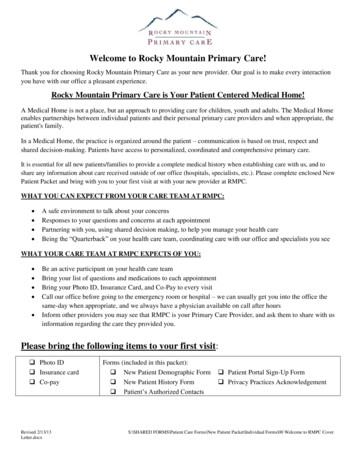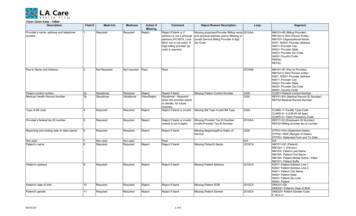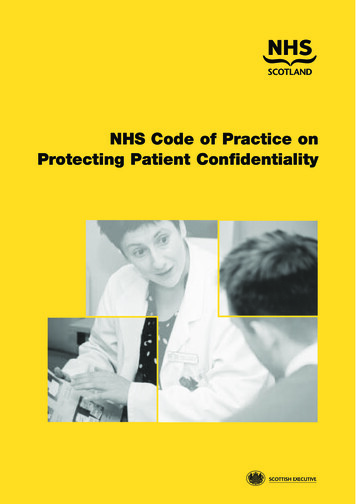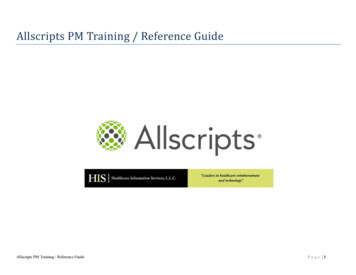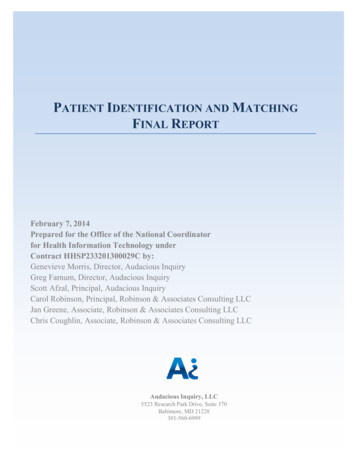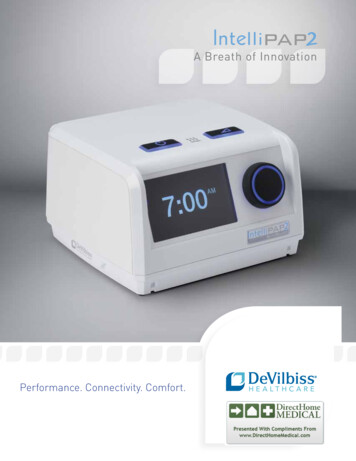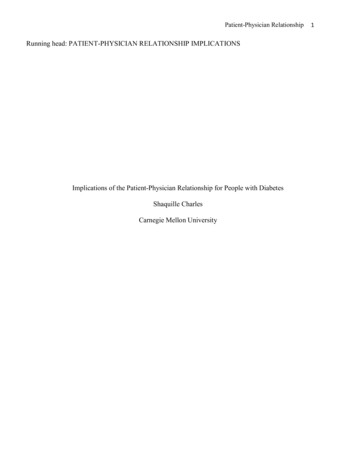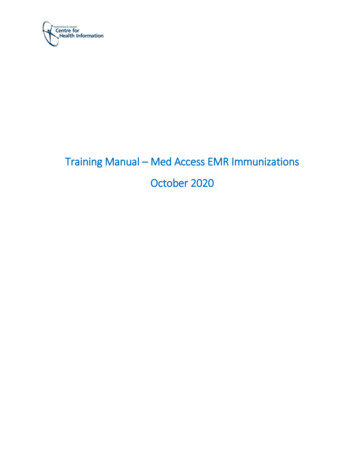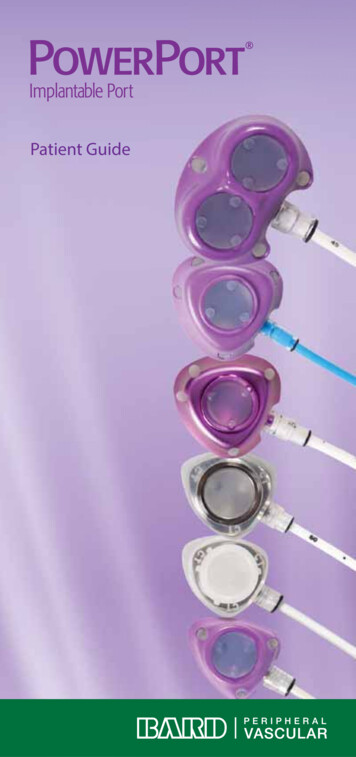
Transcription
Patient Guide
Table of ContentsIntroductionIntroductionYour Bard PowerPort Implanted PortHow Your Port Is Used345IdentificationHow to Know Your Port is a Bard PowerPort Device6AccessHow is Your Port Accessed?8CareCare of Your Port8Heparin LockAbout Heparin Locks9Power Injection/CECT ScansAbout Power-Injected CECT ScansWhat Your Clinician Should Know910Q&ACommon Questions and Answers11Talk to Your ClinicianWhat to Tell Your Doctor or Nurse14Patient and Companion ChecklistPatient and Companion Checklist15
Single lumen portDual lumen port
IntroductionYour doctor has prescribed a Bard PowerPort orPowerPort Groshong implantable port becauseyour treatment requires repeated injections ofmedicine into your blood. You may also needpower-injected Contrast-Enhanced ComputedTomography (CECT) scans. This port will allow youto receive all of these treatments without the needfor more needle sticks in your arm or leg veins.Please read all of the information in this PatientGuide. It is designed to help you understand andfeel comfortable with your port.Not every port is able to receive fluid at a high rate(power injection). You should inform your nursethat your port is a Bard PowerPort or PowerPort Groshong implantable port. You should also carryyour port patient identification card with you.This card lets nurses know that you have a Bard PowerPort or PowerPort Groshong implantableport. It also gives them important information theyshould know about the port.If you have questions about your port, please talkto your doctor or nurse.3
Your Bard PowerPort Implanted PortYour Bard PowerPort implanted port is a smalldevice (about the size of a quarter). It is used tocarry medicine into the bloodstream. The port hasone or two small basins that are sealed with a softsilicone top, called a septum. The port is placedunder the skin on your chest or arm. The portconnects to a small, soft tube called a catheter. Thecatheter is placed inside one of the large centralveins that take blood to your heart. When a specialneedle is put into the septum, it creates “access”to your bloodstream. Medicine and fluids can begiven through the needle and blood samples canbe withdrawn.Your port has three bumps on top of each septum.The port with one septum is also shaped like atriangle. These features help the nurse know thatyour port can be power injected.PowerLoc needleSeptumPalpation BumpsPowerPort Implantable PortCatheterSkinBlood VesselYour PowerPort implanted port may be pairedwith a Groshong port catheter. The Groshong catheter is a rounded tip, silicone catheter witha three-position valve placed in the side of thecatheter near the tip. The valve of the Groshong catheter allows fluids to flow in or out of thecatheter but remains closed when it is not beingused.4
How does the Groshong Valve Work?The valve works when pressure is applied to it.When a negative pressure (suction) is applied(usually by a syringe), it causes the valve to openinward, allowing your blood to flow through thecatheter into the syringe. When a liquid, (e.g.medication, nutritional supplements, saline orblood) is introduced into the catheter lumen, thepositive pressure pushes the valve open outwards,letting liquid enter the bloodstream. At neutralpressure, the valve remains closed, reducing therisk of air entering or fluids moving in or out of thecatheter.AspirationInfusionClosedWhy use the Groshong Catheter?Some patients may be hypersensitive to heparinor suffer from heparin induced thrombocytopenia(HIT). The Groshong catheter may be flushed withsterile normal saline and does not require heparinto maintain patency. Additionally, the Groshong port catheter grants longer periods betweenmaintenance flushes which means less trips to thehospital.How Your Port is UsedYour doctor or nurse can give medicines or fluidsthrough your port. They may also take bloodsamples. They will not need to stick the veinsin your arms with a needle. This makes it morecomfortable for you. The medicines mix better inthe blood, because the port delivers medicines intoa large central vein.5
The Bard PowerPort or PowerPort Groshong implanted port is used with a Bard PowerLoc Safety Infusion Set needle. Your port can receive apower injection when used with this needle. Thiswill help tissue in your body show up more clearlyduring medical imaging. This helps your doctormonitor the status of your condition. Powerinjected CECT scans are safe and non-invasive. Theygive important information about your disease andtreatment.IdentificationHow to Know Your Port is a Bard PowerPort orPowerPort Groshong Implantable PortYour doctor or nurse gave you a packet when youreceived your port. This packet had a bracelet,key ring card, and identification card inside. Theseitems help the nurse or doctor know that you havea Bard PowerPort or PowerPort Groshong implantable port. You should always keep yourpatient identification card with you. Show it to thenurse before your port is accessed for treatment.You can tell the nurse you have a Bard PowerPort or PowerPort Groshong implantable port.6Key Ring CardIdentification CardPowerPort BraceletPowerPort Groshong Bracelet
Your patient chart should also show that you havea Bard PowerPort or PowerPort Groshong implantable port.The port has a special triangle shape and threebumps on top of the septum. Your doctor ornurse can feel these bumps and the triangle portshape to know that you have a Bard PowerPort implantable port.Ask your doctor or nurse to help you feel the shapeand bumps of your port.Feel the soft top of the port for the three bumps. Feel the sidesof the port for the triangle shape.A trained clinician can also recognize the Bard PowerPort implantable port in an X-ray. A specialsymbol located on the port is visible under x-ray. Sample X-ray ofPowerPort device7
AccessHow is Your Port Accessed?Your doctor or nurse will use the port whenthey need to administer medicine and fluids orwithdraw blood samples. To do this, they willaccess the port by placing a special needle, calleda Huber needle, into the port. You may feel a mildpricking when they put the needle into the port.This sensation often gets milder over time. Ask yourdoctor or nurse what you should expect.CareCare of Your PortAfter your port is placed, your doctor will place asmall bandage over the incision. For the first fewdays, you should avoid heavy exertion and followany special guidance from your doctor or nurseto care for the small incision. The incision will nottake any special care once it is healed. You can thenresume normal activities.8
Heparin LocksAbout Heparin LocksSometimes blood can clot and block the catheter.Clots prevent medicine and fluid from flowingthrough it. Blood will not clot when it is thinnedwith a medicine called heparin. Ports with openended catheters are often filled with a sterilemixture of saline and heparin to prevent clots. Thisprocess is called a heparin lock. If your port willnot be used for a long period of time, the doctoror nurse will usually change the heparin lock everyfour weeks.If you are allergic to heparin or have HeparinInduced Thrombocytopenia (HIT), you should tellyour doctor or nurse anytime the port is used.PowerPort Groshong ports can be locked usingonly sterile normal saline without heparin for 90days, if required. This is a good option if you areallergic to heparin.Power Injection/CECT ScansAbout Power-Injected CECT ScansCECT scans are simple, safe, and non-invasiveprocedures. These scans aid in disease diagnosisand treatment. They are more sensitive than x-rays.Your doctor may see small differences in your softtissue that they may not see with normal x-rays.The clinician will inject a special fluid through yourport before doing a CECT scan. This fluid, calledcontrast media, makes the picture taken with thescan much clearer. For best results, the contrastmedia is infused into your blood at a high rate. Thisprocess is called power injection.9
A Bard PowerPort or PowerPort Groshong implanted port, when used with a special needle,allows clinicians to perform power-injected CECTscans. They will not need to put a needle into yourarm or leg veins.CECT WorkstationContrast-Enhanced Computed Tomography (CECT)ScansWhat Your Clinician Should KnowShow your Bard PowerPort or PowerPort Groshong implanted port patient identificationcard to the clinicians that do your CECT scan. Thistells them that you have a PowerPort implantedport.10
Show your identification card before your port isaccessed for a treatment.Q&ACommon Questions and AnswersHow do I care for my port?During the first few days after receiving your port,avoid any heavy exertion and follow all specialinstructions that your doctor or nurse gives for careof the small incision. Follow the instructions of yourhealthcare provider for care and maintenance ofyour port once it is implanted.After each treatment, and occasionally betweentreatments if your port is not used often, the portand catheter are flushed with a special solution.If your doctor has asked you to help with theseprocedures, you will receive special training andinformation to help you accomplish this.Will the port affect my daily activities?Once the incision heals, you should be able toreturn to your normal activities. Ask your doctor ornurse about specific activities and when to resumethem.11
Will I need to wear a bandage over the port?A bandage will be needed until the incision heals.A bandage may be applied to stabilize and protectthe needle while you are receiving treatment.Do I have to stop wearing certain types of clothing?Ask your doctor or nurse. The answer will dependon where your port is placed.Who pays for the port?Insurance policies vary. Check with your insurancecompany.Will the port activate security alarms?Security systems may detect the small amount ofmetal in the device. If this occurs, simply show thePatient Identification Card for your device.How long will I have my port?The port can stay in place as long as your doctordetermines that you need it.Will my port need to be accessed when not in use?Yes. It will need to be flushed every 28 days, orevery 90 days for PowerPort Groshong ports.Can the device be removed if I no longer need it?Yes. The port can be removed with a minor surgicalprocedure similar to the one used to place it.What if my nurse has not seen a patient with a Bard PowerPort or PowerPort Groshong implanted portbefore?Always show your nurse your patient identificationcard. This card gives your clinician needed12
information about the port. If they have morequestions, they can call the Clinical InformationHotline at 800-443-3385.Can I get a CT procedure with a Bard PowerPort orPowerPort Groshong implanted port?Yes. The materials used in the Bard PowerPort orPowerPort Groshong implantable port are safefor use in CT and CECT procedures.Can I get an MRI procedure with a Port in place?Yes. You may get an MRI with this device. Theremay be some specific conditions for your device. Besure your clinician checks the MRI guidelines for thedevice. If they have more questions, they can callthe Clinical Information Hotline at 800-443-3385.What do I do if I have a question or suspect a problem?You may see some redness and tenderness in thearea after the procedure. This should go away in24 to 48 hours. Contact your doctor or nurse ifyou notice unusual changes in the skin such asincreased swelling, redness or soreness. If you havepain, fever, chills, shortness of breath, or dizziness,contact your doctor right away.What do I do if my doctor or nurse is unavailable?You will be given a wallet-sized PatientIdentification Card. This card has importantinformation about the port. With this information,other medical personnel will be able to help you.Talk to Your ClinicianAs a new patient with a port, the best way to beinvolved is share information and concerns withyour doctor or nurse. Speak up. Ask about your13
concerns, or if you see anything that seems odd.What to Tell Your Doctor or Nurse. You have a Bard PowerPort or PowerPort Groshong implanted port. If you notice any redness or swelling at the site ofyour port after the wound heals. If you have a fever. If you have allergies to any medicines ormaterials. If you have an allergy to heparin. If you have ever been treated for HeparinInduced Thrombocytopenia (HIT). If you have ever been given blood thinningmedicines such as heparin or warfarin. If you have been treated with radiation before. If you have ever been diagnosed with lungdisease. If you have ever been diagnosed with, or treatedfor blood clots in your veins (venous thrombosis). If you have ever been diagnosed with any tissuedisease or suffered from tissue erosion. If you have been diagnosed with or tested for“pinch-off” syndrome. If other clinicians have ever had difficultydrawing blood or putting fluids through yourport. Let them know if other clinicians have askedyou to change position to allow blood or fluid toflow.14
Patient and Companion ChecklistThe Bard PowerPort or PowerPort Groshong implantable port is a new kindof implantable port. It provides access forIV treatments and Power-injected ContrastEnhanced Computed Tomography (CECT)scans.ƑƑƑƑƑPatients should get an identification card,bracelet, and key ring card when the Bard PowerPort or PowerPort Groshong implantable port is placed. These can let theclinician know the port is a Bard PowerPort implantable port.Patients should keep their identification cardwith them. They may also wear the braceletand carry the key ring card.Show the identification card to the nurse whenthe port is accessed. This card has importantinformation for the nurse. If they needmore information, they may call the ClinicalInformation Hotline at 800-443-3385.Speak up. Share information with clinicians.Ask about anything that concerns you orseems unusual.15
Distributed by:Bard Peripheral Vascular1415 West Third StreetTempe, AZ 85281 USA480-894-9515Clinical Information Hotline: mwww.powerportadvantage.comwww.veins4life.comBard, Groshong, PowerLoc, PowerPort andthe radiopaque symbol are trademarks and/orregistered trademarks of C. R. Bard, Inc. 2014 C. R. Bard, Inc. All rights reserved.0735582 1405R
catheter is a rounded tip, silicone catheter with a three-position valve placed in the side of the catheter near the tip. The valve of the Groshong catheter allows fluids to flow in or out of the catheter but remains closed when it is not being used. PowerLoc needle PowerPort Implantable Port Palpation Bumps Septum Catheter Blood Vessel Skin
